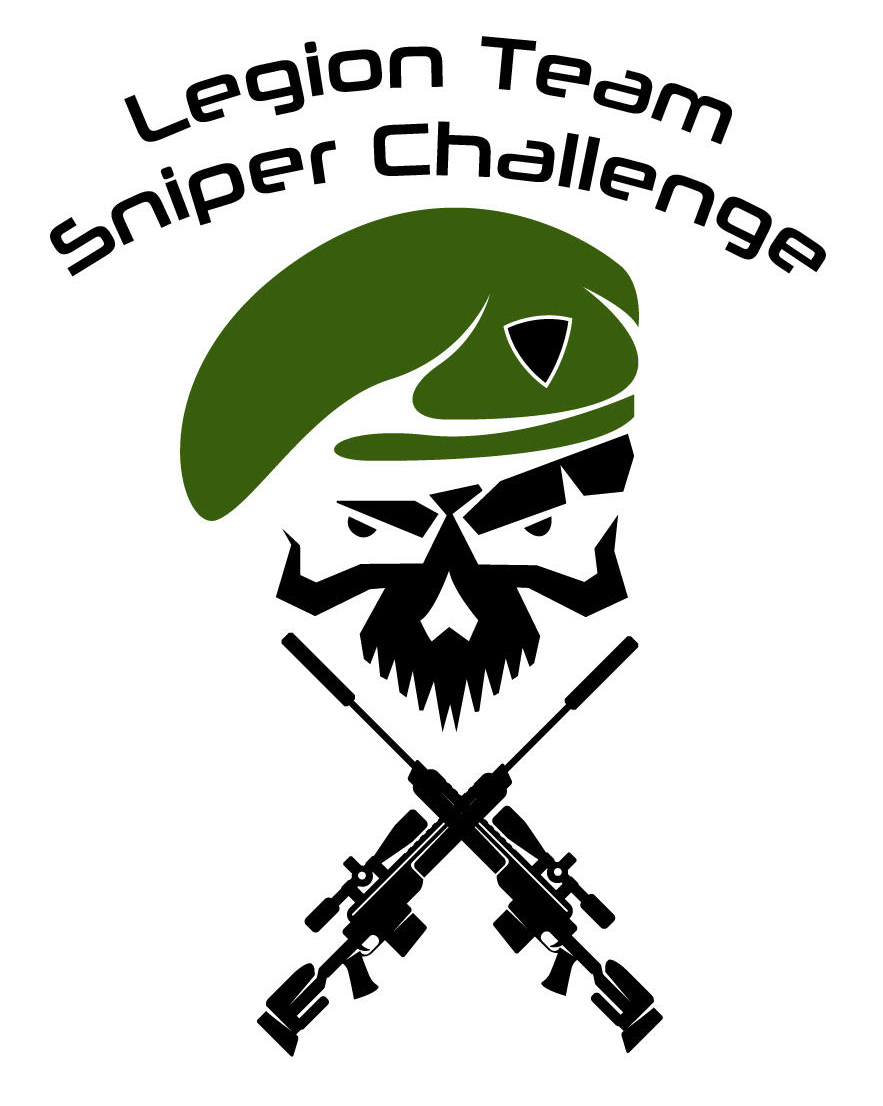The inaugural Legion Team Sniper Challenge was held at the 5th Special Forces Group range complex on Fort Campbell. This invite-only event was the brainchild of two friends of mine, Adam Burt and Matt Masterson. Adam has been around the industry as the General Manager of a well-known performance rifle company, while Matt recently retired from a career in Special Operations. We’ve crossed paths many times through various competitive shooting events, and both are solid competitors and good human beings. When they called and said they were putting a little something together that would be challenging and a good time, my answer was to let me know when and where, and my shooting partner Greg and I would be there.
If you enjoy team-competitive shooting events, we are fortunate to see more great events get added to the match calendar. Team events are fun because the stages are generally more complex, have a little more time to do stuff, and create additional challenges because one must negotiate the event with a partner. For a calendar of what I hear about, check out my annual list here.
Background
Matt and Adam started their journey to the Legion Team Sniper Challenge with discussions of creating an event that is challenging, fun, and brings awareness with some funding for Chapter 38 of the Special Forces Association (SFA). Chapter 38 of the SFA has a mission to support 5th SFG soldiers and their families, particularly when a little extra help is needed, or times are at their worst. The group works as they did in their professional careers, quietly and effectively, not seeking public recognition. That being said, money helps make things happen and it still doesn’t grow on trees. As a group that benefits professional shooters and their families, shooting events are a great way to both build the community and bring some benefit to the organization.
The Legion Team Sniper Challenge is the second event to help the Chapter, with all funds raised going to the organization. I have been fortunate to participate in the other shooting competition to benefit this organization, the Legion Memorial Run n Gun…also a fantastic event that is held in September.
Event Specifics
This competition was a 2-day affair, occurring over a Saturday and Sunday. We shot 11 different stages, spread out between several ranges. While originally being capped at 30 teams, there were a few additional military teams added at the last minute for a total of 33 competitive teams. The field was broken into 5 squads for the weekend. Each squad was a healthy mix of military teams from 5th and 3rd Group, Rangers, SFSC, and others, as well as competitive civilian teams. Quite frankly, all the teams were very competitive with a diverse set of experiences, but also great personalities that were fun to be around.
The composition of the team included a primary rifle shooter and a secondary carbine shooter. The rifle was required to be of .308, 6.5 Creedmoor, or .300 Win Mag (all current military sniping rounds). Carbines were limited to 5.56 only, with an 18” maximum barrel length and optics limited to no more than 10x. 9mm pistols were also required for each team, but everything else was open to bring if you could carry it all day and through stages.
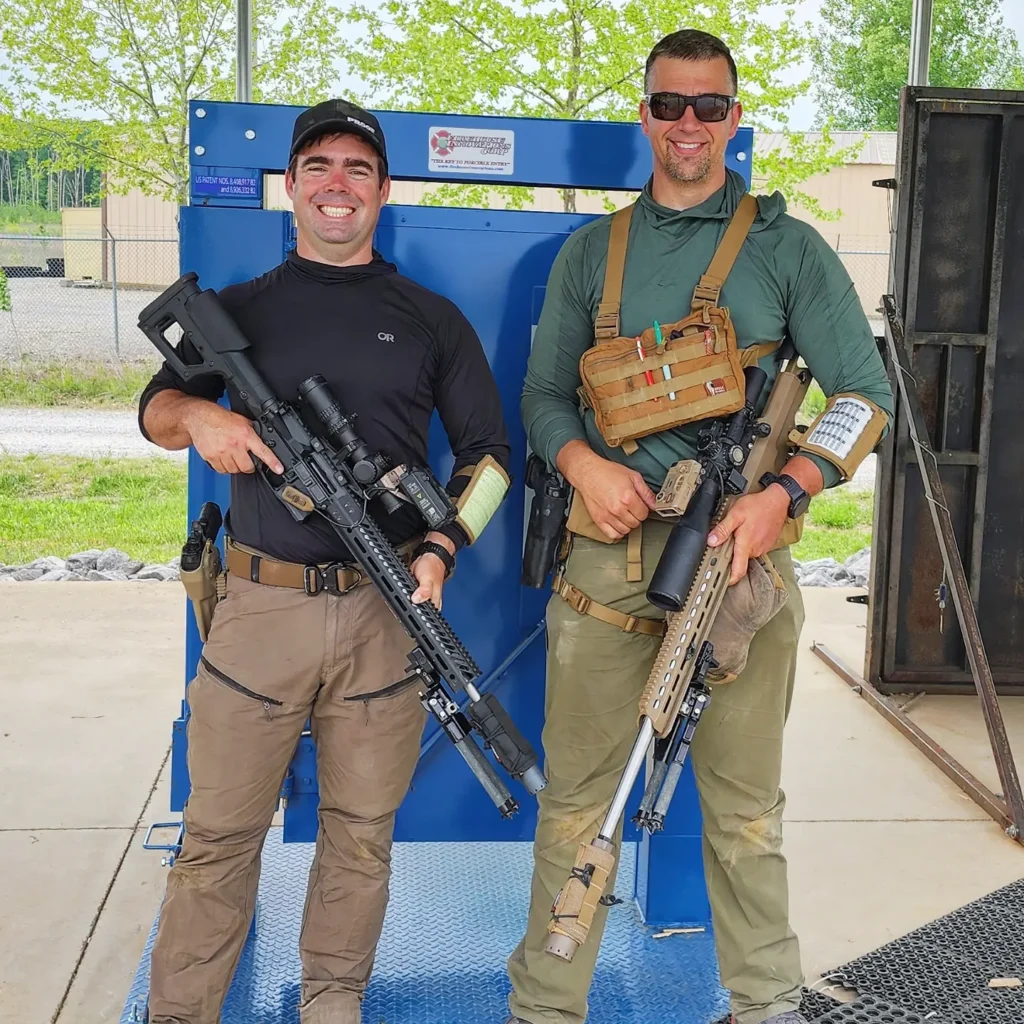
Scoring was done as time-plus, which is not common for team events like this. That being said, this was done to reward speed and add an additional layer of stress and decision-making. For the match, your stage time was recorded, and any targets that you didn’t hit with the prescribed rounds were a +30 second penalty as a Failure to Neutralize; while unengaged targets were a +60 second Fail to Engage penalty. The strategy for this was to minimize the penalties since they racked up fast.
Sign-In and Sight-In Day
For sign-in and a chance to sight in, competitors were directed to the Chapter 38 safehouse just inside the state of Kentucky. There, waivers were completed if not done ahead of time, match shirts were handed out, and a 100-yard range was available to check zero on your rifle. Additionally, a set of steel targets were set up to warm up a bit with your own pistol…as well as check out demo Staccato P 2011s that the company sent out.
The competitor briefing held everyone’s attention, as the match directors purposely sent out minimal information. We knew what firearm requirements we had, and that the event was made to be stressful and challenging like a military stress shoot. At the briefing, Adam and Matt let us know this wasn’t just another match but were going to make it harder by limiting information, inducing stress, frustration, and raising heart rates as part of the match design. They also enlisted the help of the 5th Group sports psychologist to ensure they had achieved their objectives. Finally, they finished the brief by stating if we were frustrated, confused, and/or upset at a stage, it was likely by design.
Day 1
The first day of the Legion Team Sniper Challenge comprised six stages, and we began pretty much on time at 8 am. We began on Stage 6, appropriately titled “Spicy Infil.” The theme names proved to be appropriate for each stage, with the names and briefs containing much humor and innuendo. This first stage began with the team blindfolded and erratically driven the half mile to our shooting area. Information was limited, other than I had a full-size IPSC to find and engage, while Greg had a diamond. Each target needed three hits from each of the two shooting positions on the front and back of the side-by-side that brought us in. Also, the team had three minutes to get this done once the vehicle stopped.

When we pulled into the position, music was blaring to make it more difficult to communicate. As we oriented to get set up in shooting positions, the targets were not obvious to the naked eye. They were painted black and sky-lined atop the berm at the end of the range, blending into the tree line. I found the targets first, attempting to get a lase with my RAPTAR on the rifle but was picking up multiple distances. The targets were cleverly sky-lined, and I couldn’t see any splash or trace, so I sent a shot to miss on purpose…aiming onto the berm to get a wind call and correct for any distance errors. Fortunately, I saw my bullet splash this way and made the adjustment to hammer the three hits on my target. Greg followed with a few extra shots required on his, before swapping shooting positions. I followed up with four shots needed to get three hits, with Greg finishing us out with four seconds remaining. The targets ended up being around 630 yards.
The rest of the day’s stages included:
- Dragging a full-weight Rescue Randy with some pistol shooting, followed by some hasty loophole shots.
- Clearing longer distance pistol plate racks before improvising a position to shoot precision shots on paper.
- Searching multiple rooms for target information, then finding and engaging targets.
- Advancing up four stories before making a simultaneous shot, followed by hammering some robotic moving targets.
- A positional race against time with multiple barricades and a tank trap, requiring clearing a different set of targets from each position.
After the shooting was done for the day, a gathering was had at the Leatherwood Distillery in Clarksville, TN. Most shooters made it out, enjoying some libations and food while swapping stories about the match or telling other lies.
Day 2
Our first stage of day two began with some laughs. In short, there was a shooting position and observation position, where the non-shooter was shown a picture that needed to be verbally relayed to their partner, who in turn matched it to an answer key to determine what target needed to be shot. The kicker was all the identifiers were large humans, similarly half-dressed, and information such as backgrounds or other clues were needed versus identifying the specific person. Once the first shooter engaged their targets, the roles were reversed. We saved a lot of time by recording the target distances from the first run, so then it was just figuring out what target to shoot without re-ranging everything.
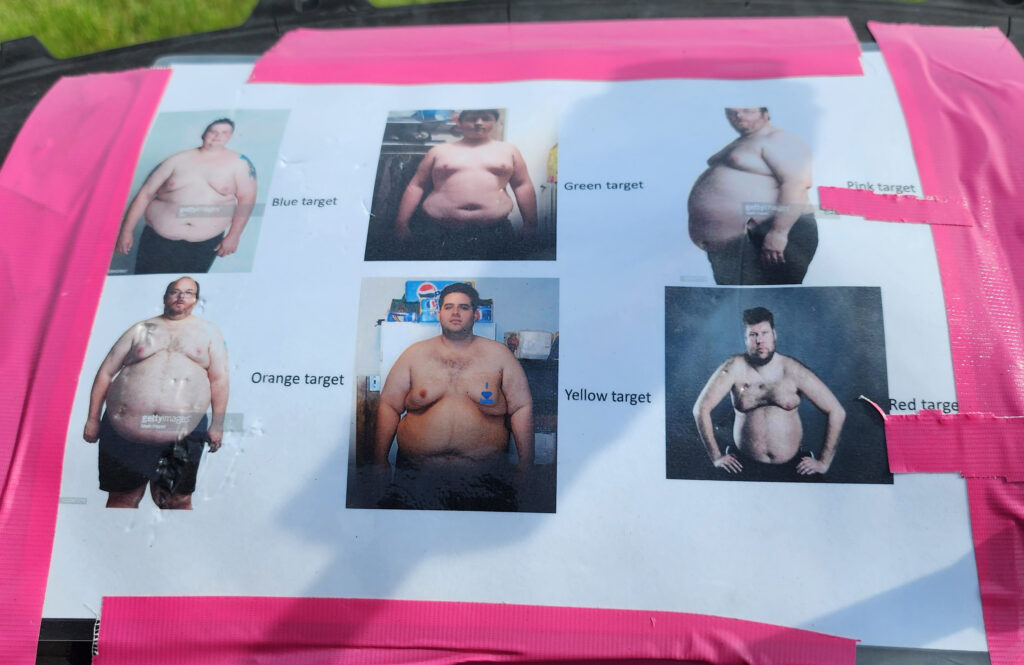
For the second stage, we had a sprint with a solo silhouette that needed to be engaged with each rifle for a hit, followed by five hits on a different target with the pistol. The rifle positions had blue paint on the barricades, and the rifles had to be touching the blue. Essentially the stage was a bounding drill with pistols and rifles.
This stage required one rifle hit per shooter, with the rifle touching the blue paint mark. Then 5 pistol hits were required on one of the steel silhouettes before team advanced to the next position.
All gear had to move with the shooters.
After this, it was a sprint into a Connex building to find and engage targets. The briefing included a target identifier made of orange tape. We ran in and started looking, and looking, and looking. What we missed was the orange tape on the wall identifying green as our target indicator. Both of us got sucked into being target focused, and hits on orange were not called. Greg did attempt the additional pistol targets, of which green was a color…earning called hits. From there, we wasted no time in schwacking the green targets. Once we were done, the RO’s had a good laugh at us when they pointed out the tape on the wall…and we had a good lesson learned. Don’t forget to look around.
The next stage was all about speed. There were two pistol plates and two sets of rifle plates at about 150ish and 300ish yards away. One start, the team moved to the first of four staircase platforms, with each shooter engaging the pistol plates for one hit each. Then either shooter could engage their rifle plates, with the carbine shooter engaging a coyote, while the rifle shooter had a prairie dog. Each target had to be struck once, then the team advanced to the next position. This continued until all four landings were cleared and the team reached the roof.
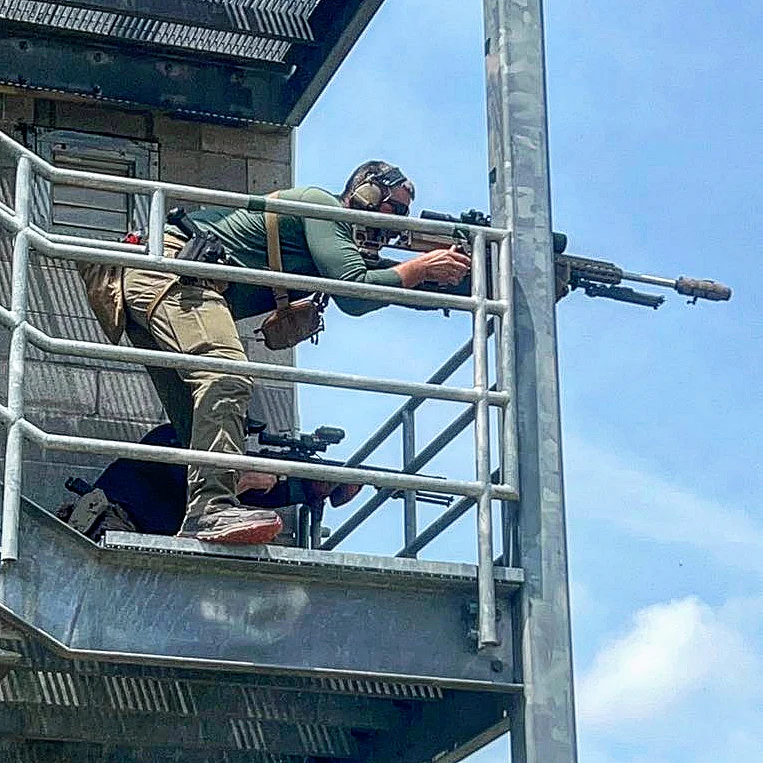
Our final stage may have been my favorite. The briefing was essentially we were to provide a rescue/armed overwatch of targets downrange. Targets were marked with purple (purple pool noodles on the t-posts), and each needed to be hit twice to neutralize. The team was briefed to move to the third floor, where an open doorway and window were provided to engage the targets. Upon the start signal, we worked our way upstairs where I settled into a prone position in the doorway opening. My rifle landed pointing at an array of appropriate targets, and without ranging I went to work. I swagged the first target at about 400 yards, and my first shot went over the top. With a gas gun, I simply corrected and got two hits. From there, I just added about a little bit more to the targets in increasing distance, quickly dispatching four of our targets. At that point, Greg hammered another target while I set up on my next. Once he recorded two hits, I immediately hammered my next target and then another that was in my field of view. Then Greg finished our last target to end our stage and match. Our time on this from the base of the stairs to all rounds complete was one minute and forty seconds.
Load Out
Our loadout for the Legion Team Sniper Challenge required a precision rifle and a carbine. Given the nature of the event and likely crowd, we ran a Barrett MRAD in 6.5 Creedmoor and a precision-built carbine.
Primary Rifle – Barrett MRAD
- Proof Research 6.5 Creedmoor pre-fit barrel, Timney Trigger, and Area 419 rail
- Hornady 135gr A-Tips at 2830 fps
- Nightforce ATACR 7-35×56 F1 with Mil-XT Reticle
- Wilcox MRF Laser Rangefinder
- KGM R30T suppressor
- MDT Ckye-Pod
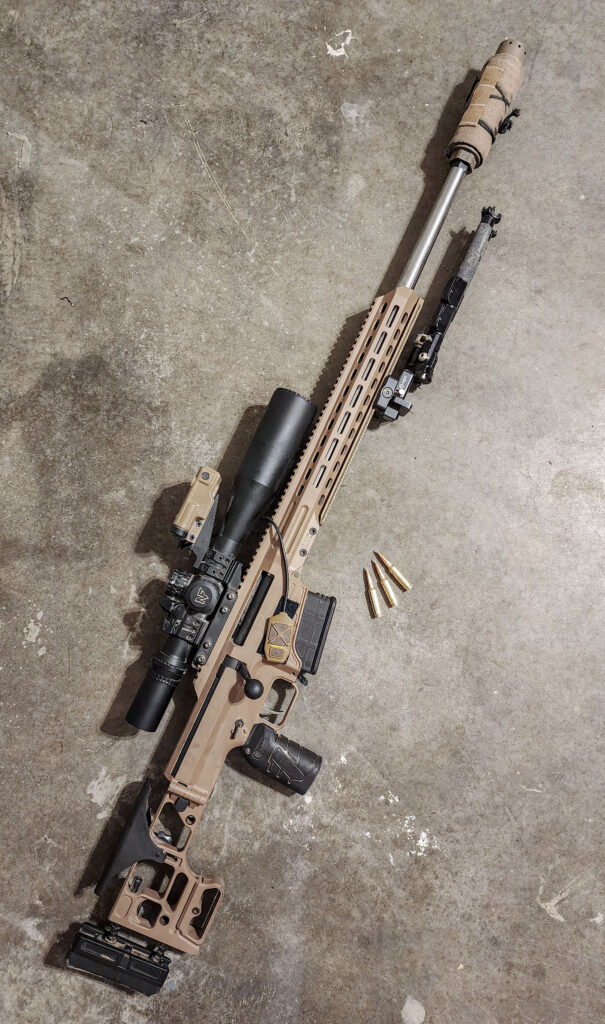
Secondary Rifle – Home-build Carbine
- Proof Research 18” Stainless barrel
- Seekins upper/handguard
- SilencerCo lower with Geissele DMR trigger, A5 buffer tube, and Magpul PRS Lite
- Hornady 73gr ELDs at 2840 fps
- Nightforce ATACR 1-8×24 F1 with FC-DMx reticle
- Wilcox RAPTAR
- KGM R6 suppressor
- MDT Ckye-Pod
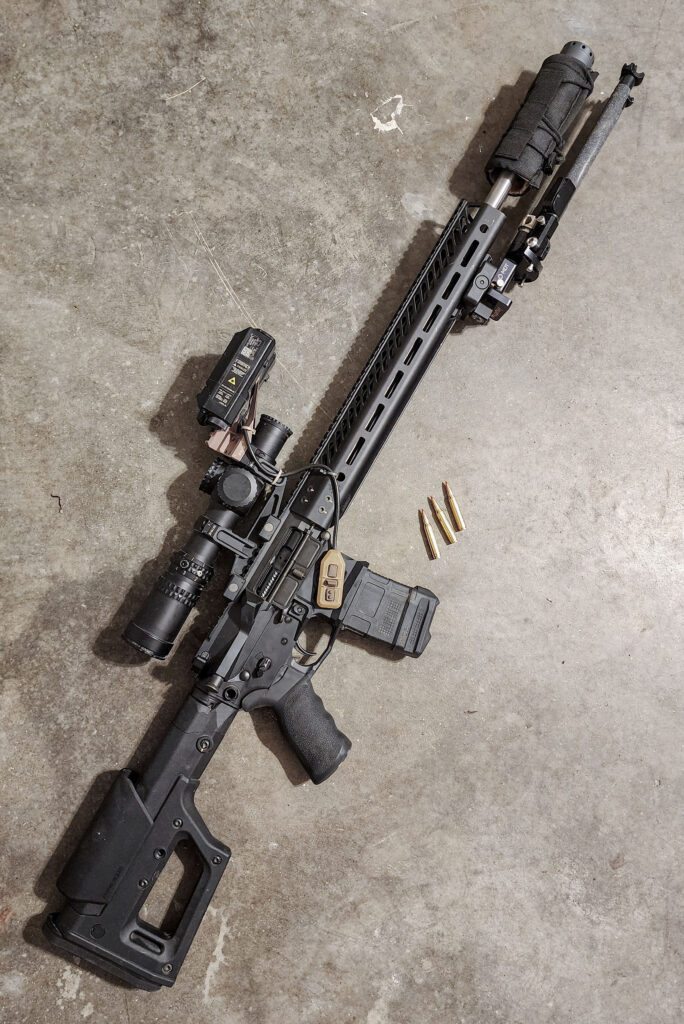
For pistols, Greg had his new EMG Custom 2011, while I had a Staccato P. Both pistols had Aimpoint Acros and Surefire lights, carried in Safariland ALS holsters.
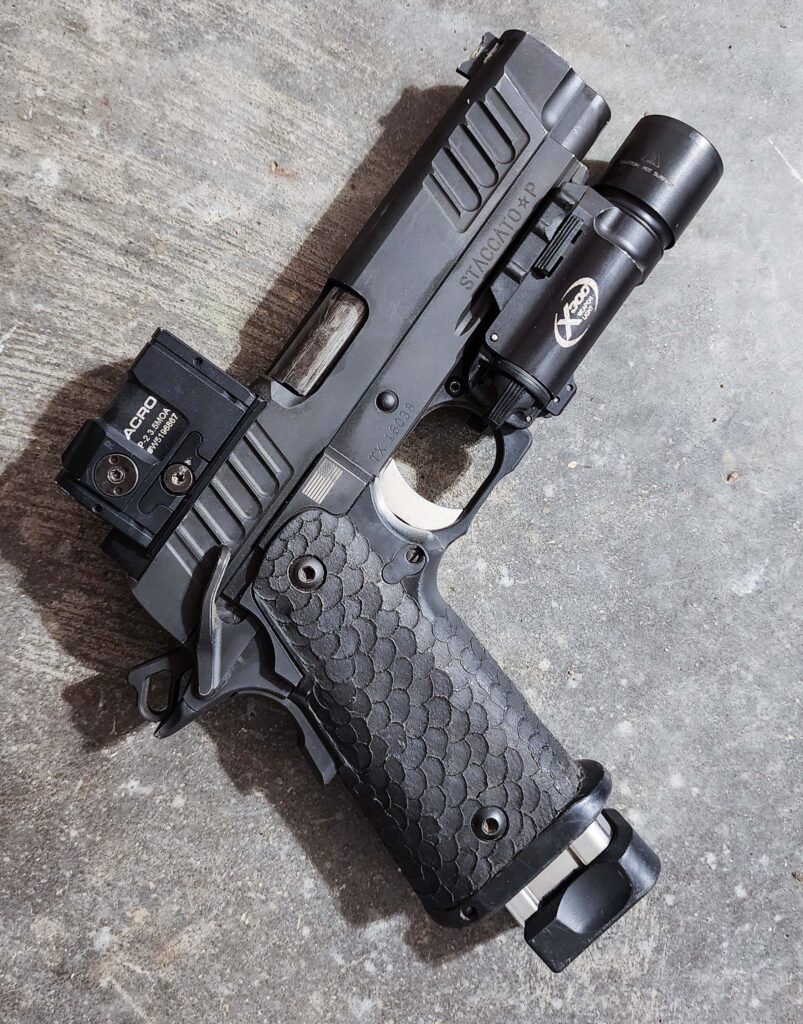
We both also carried Really Right Stuff SOAR tripods, finding a use for them on several stages.
Sponsors
Despite being an inaugural event, the industry support was outstanding. The sponsor list featured many premium brands. Many thanks to these companies, the support was noticed and appreciated!
- Seekins Precision
- Staccato
- JP Enterprises
- Proof Research*
- Nightforce Optics*
- Area 419*
- 2 Vets Tripods
- Vortex
- KRG
- X-Steel Targets
- Trainshot (moving targets)
- Burn Proof Gear*
- Real Avid*
- Burris*
- MDT*
*All the teams with an asterisk had a team present at the event as well.
Final Thoughts
The Legion Team Sniper Challenge was a special event. Top-notch military and civilian teams were gathered at Ft. Campbell to have fun and raise money for Chapter 38 of the Special Forces Association. The stages were fast-paced, challenging, and fun, requiring thinking and adaptation on the fly. Teams who could apply a diverse array of skills were able to do well, while there were lessons learned for all. Thank you to the match directors, those who took their weekends to help run the event, and fellow competitors for an incredible time. Adam and Matt have already promised bigger, badder, tougher and meaner in 2024. Given how much everyone liked it, I would expect a sell-out crowd again. Keep an eye on the website and their social media page for future information on applying for next year’s event.



